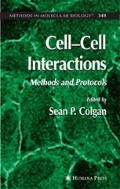Abstract
Adhesive interactions between bacterial cells coupled with adherence to a solid surface can lead to the formation of a biofilm. The important role of biofilm formation in the pathogenesis of certain types of infection, especially those involving indwelling medical devices, is becoming increasingly apparent. Critical to the development of a biofilm is the elaboration of exopolysaccharide that contributes to substrate and intercellular adhesion. The synthesis and secretion of large exo-polysaccharides is a metabolically expensive process and is therefore often suppressed under conditions that favor the planktonic mode of growth. One way to identify the environmental cues that cause a given bacterial species to switch to the biofilm mode of growth is to monitor exo-polysaccharide elaboration in vitro. The exo-polysaccharide involved in biofilm formation in a number of bacterial species is a polymer of N-acetyl-glucosamine. In this chapter, we outline two methods that use wheat germ agglutinin, a lectin that binds to N-acetyl-glucosamine, to evaluate extracellular polysaccharide production by a variety of bacterial species.
Access this chapter
Tax calculation will be finalised at checkout
Purchases are for personal use only
References
Vuong, C., Voyich, J. M., Fischer, E. R., et al. (2004) Polysaccharide intercellular adhesin (PIA) protects Staphylococcus epidermidis against major components of the human innate immune system. Cell Microbiol. 6, 269–275.
Jefferson, K. K. (2004) What drives bacteria to produce a biofilm? FEMS Microbiol. Lett. 236, 163–173.
Cramton, S. E., Ulrich, M., Götz, F., and Doring, G. (2001) Anaerobic conditions induce expression of polysaccharide intercellular adhesin in Staphylococcus aureus and Staphylococcus epidermidis. Infect. Immun. 69, 4079–4085.
Kaplan, J. B., Velliyagounder, K., Ragunath, C., Rohde, H., Mack, D., Knobloch, J. K., and Ramasubbu, N. (2004) Genes involved in the synthesis and degradation of matrix polysaccharide in Actinobacillus actinomycetemcomitans and Actinobacillus pleuropneumoniae biofilms. J. Bacteriol. 186, 8213–8220.
Mack, D., Fischer, W., Krokotsch, A., et al. (1996) The intercellular adhesin involved in biofilm accumulation of Staphylococcus epidermidis is a linear beta-1, 6-linked glucosaminoglycan: purification and structural analysis, J. Bacteriol. 178, 175–183.
Maira-Litran, T., Kropec, A., Abeygunawardana, C., Joyce, J., Mark, G., 3rd, Goldmann, D. A., and Pier, G. B. (2002) Immunochemical properties of the staphylococcal poly-N-acetylglucosamine surface polysaccharide. Infect. Immun. 70, 4433–4440.
Wang, X., Preston, J. F., 3rd, and Romeo, T. (2004) The pgaABCD locus of Escherichia coli promotes the synthesis of a polysaccharide adhesin required for biofilm formation, J. Bacteriol. 186, 2724–2734.
Leriche, V., Sibille, P., and Carpentier, B. (2000) Use of an enzyme-linked lectinsorbent assay to monitor the shift in polysaccharide composition in bacterial biofilms, Appl. Environ. Microbiol. 66, 1851–1856.
Thomas, V. L., Sanford, B. A., Moreno, R., and Ramsay, M. A. (1997) Enzymelinked lectinsorbent assay measures N-acetyl-D-glucosamine in matrix of biofilm produced by Staphylococcus epidermidis. Curr. Microbiol. 43, 249–254.
Vuong, C., Kocianova, S., Voyich, J. M., et al. (2004) A crucial role for exopolysaccharide modification in bacterial biofilm formation, immune evasion, and virulence. J. Biol. Chem. 279, 54,881–54,886.
Costerton, J. W., Stewart, P. S., and Greenberg, E. P. (1999) Bacterial biofilms: a common cause of persistent infections. Science 284, 1318–1322.
Author information
Authors and Affiliations
Editor information
Editors and Affiliations
Rights and permissions
Copyright information
© 2006 Humana Press Inc.
About this protocol
Cite this protocol
Jefferson, K.K., Cerca, N. (2006). Bacterial–Bacterial Cell Interactions in Biofilms: Detection of Polysaccharide Intercellular Adhesins by Blotting and Confocal Microscopy. In: Colgan, S.P. (eds) Cell-Cell Interactions. Methods in Molecular Biology™, vol 341. Humana Press. https://doi.org/10.1385/1-59745-113-4:119
Download citation
DOI: https://doi.org/10.1385/1-59745-113-4:119
Publisher Name: Humana Press
Print ISBN: 978-1-58829-523-1
Online ISBN: 978-1-59745-113-0
eBook Packages: Springer Protocols

